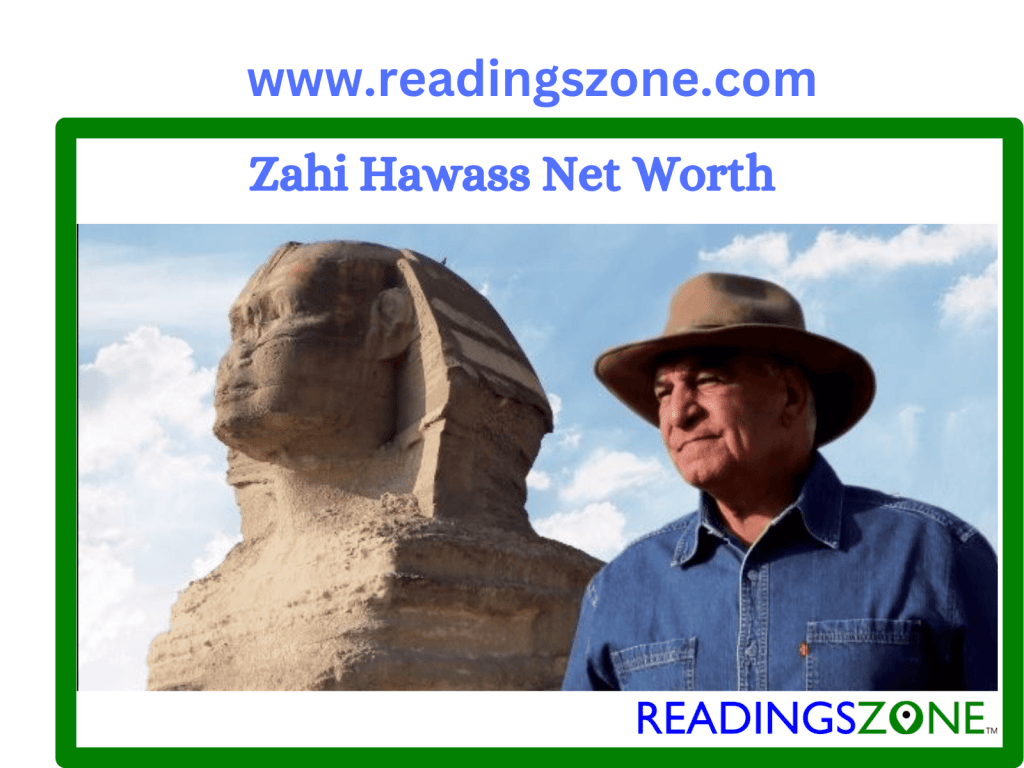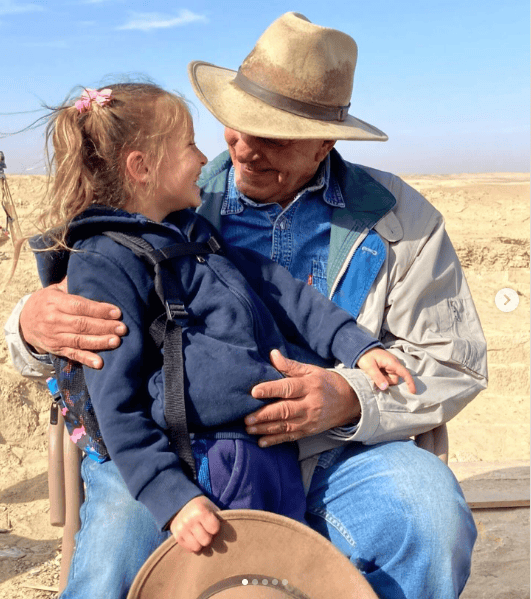Zahi Hawass's Net Worth & Bio: Peering into Egypt's Archaeological Guru[2025]
Table of Contents
Toggle
Listen to this article on Audiomack
Please enter a valid URL
Zahi Hawass is one of the most famous people in Egyptology. People look up to Hawass for his contributions to historical study, charisma, and work to protect Egypt’s cultural history. In summary, he has made a lasting impact on the field. Here, we explore Zahi Hawass’s fantastic journey through Egypt’s historical, cultural, and political arenas. People are also curious to learn about his net worth, family, and personal life at the same time.
Explore the American great artist Woodie Guthrie’s net worth & wiki details
Zahi Hawass’s net worth
According to the New York Times, Hawass received an honorarium of $200,000 from National Geographic only to be an explorer in residence. And this list is long! According to the news, Zahi Hawass also has a business relationship with two American Companies that do business in Egypt. From different financial sources, we can estimate Zahi Hawass’s net worth as $2M-$3M
A Quick Scan of Zahi Hawass’s bio
| Topic | Details |
| Full name | Zahi Abass Hawass |
| Birth | May 28, 1947, near Damietta, Egypt |
| Nationality | Egyptian |
| Education | – B.A. in Greek & Roman Archaeology, Alexandria University (1967) – Postgraduate diploma in Egyptology, Cairo University (1979) – Fulbright Fellow – M.A. & Ph.D. in Egyptology, University of Pennsylvania (Ph.D. 1987, dissertation on Khufu, Khafra, Menkaura funerary establishments) |
| Key positions | – Secretary-General, Supreme Council of Antiquities (2002–2011) – Minister of Antiquities/State for Antiquities (two brief terms in 2011) |
| Major achievements | – Preservation and excavation of Giza monuments – Discovery and study of pyramid builders’ tombs – Discovery of Valley of the Golden Mummies (1996) – Led DNA study on King Tutankhamun’s family |
| Repatriation work | – Campaigned for return of iconic Egyptian artifacts (e.g., Rosetta Stone, Nefertiti Bust) – Oversaw antiquities security & conservation |
| Public image | Known for charisma, media presence, and strong personality; often compared to a “guardian” of Egypt’s past |
| Media presence | – Frequent expert on National Geographic, Discovery, History Channel – Hosted “Chasing Mummies” (2010, History Channel) |
| Publications | – Giza and the Pyramids (with Mark Lehner) – The Valley of the Golden Mummies – Multiple books for both scholars and general readers |
| Awards & honors | – National Geographic Explorer-in-Residence – Honorary doctorate, University of Pennsylvania (2000) – Multiple international recognitions |
| Conservation & repatriation work | Longtime campaigner to repatriate iconic artifacts (e.g., Nefertiti bust, Rosetta Stone); oversaw museum/site security and restoration; frequently negotiated returns of looted pieces. |
| High-profile research leadership | Led the team behind the King Tut family DNA project published in JAMA; served as National Geographic Explorer-in-Residence. |
| Controversies | During Egypt’s 2011 unrest, he was appointed as a minister, briefly sentenced in a court case involving a land dispute and administrative matter, and subsequently acquitted a few months later. |
| Notable press profiles | In-depth features in The New Yorker and Smithsonian cover his influence and controversies. |
| Recent activity | – Still leading excavations and discoveries (e.g., Luxor finds, Hatshepsut temple blocks in 2025) – Continuing repatriation campaigns |
| Website | hawasszahi.com |
Early life & education
Zahi Hawass was born in a small village near Egypt’s port city of Damietta on May 28, 1947. According to Mr. Hawass’s official website, he wanted to be a lawyer, and he went to school to study law at the age of 15. But he soon lost interest in law.
When he was 20 years old, Zahi graduated from Alexandria University (1967) with a bachelor’s degree in Greek and Roman archaeology. After graduation, the government hired him as an Inspector of Antiquities. Later, he earned a short course in Egyptology at Cairo University in 1979.
Zahi was awarded a Fulbright scholarship at the University of Pennsylvania in Philadelphia. He successfully defended a Ph.D. (1987) thesis in Egyptology on “The Funerary Establishments of Khufu, Khafra, and Menkaura During the Old Kingdom.”
Even when he was a little boy, he loved reading about old Egyptian stories. He thought the stories about mummies and pyramids were the coolest!
When he grew up, Zahi went to school to learn even more about ancient Egypt. He went to big universities, where they taught him all about ancient Egyptian history. The summary of his academic education is very colorful and bright. Here is a glimpse of his education.
Zahi Hawass discovery
Zahi Hawass is responsible for discovering many archaeological sites, including the tombs of the pyramid builders at Giza and the Satellite pyramid of Khufu. He led a team that explored the CT Scan of Tutankhamun and opined that the king died due to malaria and a leg fracture.

Pic credit: Instagram
Dr. Zahi Hawass has an impressive record of discoveries that seems never-ending. Major news sources describe his findings as resembling a living history book. Each excavation he leads reveals another missing piece of Egypt’s amazing story. He has discovered royal tombs buried under the desert sands. He has also given new life to hieroglyphics carved thousands of years ago. His work has transformed our understanding of the ancient world.
This is even more thrilling because his work goes beyond pharaohs and pyramids. It links us to real people who lived thousands of years ago. Every discovery feels like unlocking a hidden door to the past. It shows us that ancient Egypt was more than just stone and sand. It was a vibrant world filled with families, workers, priests, and kings. Hawass brings history to life. He shows us that these treasures are not just old artifacts; they are parts of a story we all share.
Zahi Hawass’ latest news
After the revolution in 2011, Hawass stopped working for the government and started doing his archaeology work. Currently, he’s busy digging up ancient things in places like Saqqara and Luxor. He’s also working on the Scan Pyramids project, and soon, he’ll start exploring a new place called the Valley of the Marks.
Recently, he wrote an incredible French story about a famous ancient king and made an opera about another famous king, which will be shown in 2024. When he’s not digging or writing, he likes to relax by smoking a cigar and watching old cowboy movies. Hawass sure knows how to keep busy and have fun!
Egyptian antiquities minister
Zahi Hawass was a minister of Antiquities during the regimes of two prime ministers, including Hosne Mobarrak(January 31 January 2011) and Essam Sharaf(March 30, 2011).
Egyptian Antiquities Minister Dr. Zahi Hawass’s term was crucial to Egypt’s cultural preservation efforts. His anti-looting, conservation, and public awareness efforts forever changed Egypt’s ancient environment.
Zahi Hawass family
According to Hawass’s official website, & other sources, Zahi Lives a very happily coupled life; His spouse’s name is Fekhira. They have two adorable sons.

Zahi Hawass’ age & physical descriptions
In 2025, Zahi Hawass turned 78 years old. So, what? He always remains busy. However, we need help finding trustworthy information regarding his physical description. While we see that he is with President Barack Obama (1.87 m), there is little height difference between him and him.
Anyhow, we see -he has dark brown hair along with eyes of the same color.
Zahi Hawass on social media
Zahi regularly posts on social media about his excavations, tours, and family time.
Facebook has 1 M follower
Instagram has 138k followers
On social media, we find Zahi Hawass to be a hard worker, a relentless discoverer, and a fantastic tourist globally.
Zahi Hawass Books
Zahi Hawass’s creative world is very long & resourceful at the same Time! Yes, he wrote more than 30 books related to mummies, pyramids & Egyptian archaeology. Out of those are-
- The Great Book of Ancient Egypt: In the Realm of the Pharaohs, London, ed. White Star, 2018
- Giza and the Pyramids, London, ed. Thames & Hudson Ltd, 2017
- Cleopatra: The Search for the Last Queen of Egypt, Washington, D.C., ed. National Geographic Society, 2010
- Tutankhamun: The Mystery of the Boy King, London, ed. National Geographic Society, 2005
- The Egyptian Monuments: Problems and Solutions, Berlin, ed. Gruyter, 1995
- The Treasures of the Pyramids, London, ed. White Star, 2003
Recognition & awards
Hawass is the first recipient of the Egyptian State Award for the Sphinx restoration project. In 2002, he was awarded the American Academy of Achievement’s Golden Plate. Time magazine named him one of the 100 most influential people in the world in 2006. In 2015, he was awarded the Golden Memorial Medal of Charles University.
The Academia Brasileira de Letras awarded Hawass as an outstanding archaeologist for writing more than 30 books in the field. He has received honors from France, Austria, Peru, Italy, Japan, and others.
Final talks
Zahi Hawass was raised in a small town in Egypt, away from the limelight. Initially, he never imagined he would become an archaeologist. Once he found his passion for history and the mysteries of ancient Egypt, he never turned back. After years of study and many hours spent in the hot desert sands, he transformed that passion into a lifelong mission.
His story shows that hard work and a passion for learning can transform a life entirely. Hawass started as a curious student and became one of the most famous figures in archaeology around the globe. He proved that anyone can achieve greatness. You don’t need to be born famous or wealthy. All you need is determination, courage, and a dream you won’t give up on.
Frequently Asked Questions about Dr. Zahi Hawass
1. What did Zahi Hawass steal?
There are rumors that Dr. Hawass stole artifacts. However, no evidence has ever confirmed this claim. In truth, he is recognized for defending Egypt’s treasures, not for stealing them. Throughout his career, he led significant efforts to return iconic artifacts such as the Rosetta Stone in London and the Nefertiti Bust in Berlin. He chose hard work over theft. He dedicated himself to returning stolen history to Egypt, reminding everyone that these treasures rightfully belong to the land of their origin.
2. What is Dr. Zahi Hawass doing now?
Even after stepping down from his government role in 2011, Hawass remains one of the most active archaeologists today. He keeps leading digs at places like Saqqara, Luxor, and the Valley of the Kings. There, he and his teams are constantly uncovering tombs, statues, mummies, and even ancient texts. In addition to his fieldwork, he travels around the world to give lectures and exhibitions that attract large audiences. He writes books, appears in documentaries, and tirelessly works to protect Egypt’s heritage. In simple terms, he remains the leading figure in modern Egyptology.
3. Does Zahi Hawass have a PhD?
Yes, Dr. Zahi Hawass holds a Ph.D. in Egyptology. He got it in 1987 from the University of Pennsylvania. He researched the funerary temples of the pyramid builders Khufu, Khafre, and Menkaure. These are the kings who constructed the Giza pyramids. His advanced degree, along with years of practical excavation experience, earned him a reputation as both a passionate explorer and a respected scholar.
4. Did Zahi Hawass find the pyramid of Huni?
Dr. Hawass did not discover the pyramid of King Huni. The Meidum Pyramid is thought to be associated with Huni. Scholars were aware of it long before Hawass began his career. He became well-known for many other discoveries. These include the Valley of the Golden Mummies in Bahariya Oasis and the cemetery of the pyramid builders at Giza. His work uncovered new insights about the workers who built the pyramids. They were not slaves; they were skilled laborers who took pride in their craft.
5. Why did Zahi Hawass blame Howard Carter?
Howard Carter is known for discovering King Tutankhamun’s tomb in 1922. However, Hawass has frequently criticized his work. Hawass claimed that Carter took items from the tomb without permission. Some artifacts from Tutankhamun later showed up in collections outside of Egypt. He also said that Carter didn’t give enough credit to the Egyptian workers who found and cleared much of the tomb. Hawass believes that Tut’s tomb should celebrate Egypt’s rich heritage and its people, rather than focusing solely on a foreign archaeologist.
6. What was found inside the pyramid?
Archaeologists have discovered mummies, sarcophagi, burial treasures, religious texts, and statues inside the pyramids. In the Great Pyramid of Khufu, a huge granite sarcophagus sits in the King’s Chamber. At places like Saqqara, archaeologists led by Hawass found tombs packed with mummified animals, golden statues, painted coffins, and papyrus documents. Every discovery feels like unsealing a time capsule. It reveals how ancient Egyptians got ready for the afterlife and what mattered most to them.
References
1.https://en.wikipedia.org/wiki/Zahi_Hawass?
2.https://www.britannica.com/biography/Zahi-Hawass?
3.https://english.ahram.org.eg/NewsContent/9/40/347/Heritage/Ancient-Egypt/Building-on-facts.aspx?
4.https://books.google.com/books/about/the_valley_of_the_golden_mummies.html?
5.https://www.reuters.com/world/egyptian-archaeologist-calls-berlin-return-nefertiti-bust-2024-09-08/?
6.https://www.nationalgeographic.com/magazine/article/tut-dna?
7.https://www.aljazeera.com/economy/2011/4/17/egypt-antiquities-chief-faces-jail-time?
8.https://www.reuters.com/world/egyptian-archaeologist-calls-berlin-return-nefertiti-bust-2024-09-08/?
9.https://www.newyorker.com/magazine/2009/11/16/the-pharaoh?
10.https://www.hawasszahi.com/bio?
